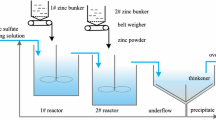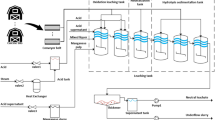Abstract
Iron precipitation is a key process in zinc hydrometallurgy. The process consists of a series of continuous reactors arranged in descending order, overflowing zinc leach solution from one reactor to the next. In this paper, according to the law of mass conservation and the reaction kinetics, a continuously stirred tank reactor model of a single reactor is first established. Then, a distributed model of cascade reactors is built with coupled control based on the single reactor model, considering the unreacted oxygen in leaching solution. Secondly, four reactors in the iron precipitation process are considered as four subsystems, the optimization control problem of the process is solved by a distributed model predictive control strategy. Moreover, the control information feedback between successive subsystems is used to solve the optimization problem of each subsystem, because of the existing control coupling in their optimization objective function of pre and post subsystems. Next, considering the intractability of the optimization problem for subsystems with various constraints, a distributed dual iterative algorithm is proposed to simplify the calculation. With the consideration of its cascade structure and control couplings, the proposed algorithm iteratively solves the primal problem and the dual problem of each subsystem. The application case shows that distributed model predictive control based on dual iteration algorithm can handle coupled control effectively and reduce the oxygen consumption.
Similar content being viewed by others
References
J. O. Claassen, E. Meyer, J. Rennie, and R. F. Sandenbergh. “Iron precipitation from zinc-rich solutions: defining the Zincor process,” Hydrometallurgy, vol. 67, no. 1, pp. 87–108, December 2002.
M. Ismael and J. Carvalho, “Iron recovery from sulphate leach liquors in zinc hydrometallurgy,” Minerals Engineering, vol. 16, no. 1, pp. 31–39, January 2003.
F. Q. Xiong, W. H. Gui, C. H. Yang, and Y. G. Li, “Dynamic modeling for process of iron precipitation based on goethite method,” Journal of Central South University (Science and Technology), vol. 43, no. 2, pp. 541–547, February 2012.
Y. F. Xie, S. W. Xie, X. F. Chen, W. H. Gui, C. H. Yang, and L. Caccetta, “An integrated predictive model with an on-line updating strategy for iron precipitation in zinc hydrometallurgy,” Hydrometallurgy, vol. 151, pp. 62–72, January 2015.
Y. G. Li, W. H. Gui, K. L. Teo, H. Q. Zhu, and Q. Q. Chai, “Optimal control for zinc solution purification based on interacting CSTR models,” Journal of Process Control, vol. 22, no. 10, pp. 1878–1889, December 2012.
M. Morari and M. Baric, “Recent developments in the control of constrained hybrid systems,” Computers and Chemical Engineering, vol. 30, no. 10, pp. 1619–1631, September 2006.
H. Peng, J. Wu, G. Inoussa, Q. L. Deng, and K. Nakano, “Nonlinear system modeling and predictive control using the RBF nets-based quasi-linear ARX model,” Control Engineering Practice, vol. 17, no. 1, pp. 59–66, January 2009.
Z. H. Xu, Y C. Zhu, K. Han, J. Zhao, and J. X. Qian, “A multiiteration pseudo-linear regression method and an adaptive disturbance model for MPC,” Journal of Process Control, vol. 20, no. 4, pp. 384–395, April 2010.
C. C. Tsai, S. C. Lin, T. Y. Wang, and F. J. Teng, “Stochastic model reference predictive temperature control with integral action for an industrial oil-cooling process,” Control Engineering Practice, vol. 17, no. 2, pp. 302–310, February 2009.
Y. Q. Wu. and R. Q. Lu, “Event-based control for network systems via integral quadratic constraints,” IEEE Transactions on Circuits and Systems I: Regular Papers, vol. 65, no. 4, pp. 1386–1394, September 2017.
Y. Q. Wu. and R. Q. Lu, “Output synchronization and L2-gain analysis for network systems,” IEEE Transactions on Systems, Man and Cybernetics: Systems, vol. 48, no. 12, pp. 2105–2114, October 2017.
K. Gaska, A Generowicz, I. Zimoch, J. Ciula, and Z. Iwanicka, “A high performance computing (HPC) based integrated multithreaded model predictive control (MPC) for water supply networks,” Architecture Civil Engineering Environment, vol. 10, no. 4, pp. 141–151, December 2017.
Y Zheng, S. Y. Li, and N. Li, “Distributed model predictive control over network information exchange for large-scale systems,” Control Engineering Practice, vol. 19, no. 7, pp. 757–769, July 2011.
J. B. Rawlings, and D. Mayne, Model Predictive Control: Theory and Design, Nob Hill Publishing, Madison, 2009.
F. Fele, J. M. Maestre, S. M. Hashemy, D. M. De. la Pena, and E. E Camacho, “Coalitional model predictive control of an irrigation canal,” Journal of Process Control, vol. 24, no. 4, pp. 314–325, March 2014.
H. D. Tuan, A. Savkin, T. N. Nguyen, and H. T. Nguyen, “Decentralised model predictive control with stability constraints and its application in process control,” Journal of Process Control, vol. 26, pp. 73–89, February 2015.
A. Zakharov, E. Zattoni, M. Yu, and S. L. Jamsa. Jounela, “A performance optimization algorithm for controller reconfiguration in fault tolerant distributed model predictive control,” Journal of Process Control, vol. 34, pp. 56–69, October 2015.
M. Zhao and B. C. Ding, “Distributed model predictive control for constrained nonlinear systems with decoupled local dynamics,” ISA Transactions, vol. 55, pp. 1–12, March 2015.
X. J. Liu, Y. Zhang, and K. Y Lee, “Robust distributed MPC for load frequency control of uncertain power systems,” Control Engineering Practice, vol. 56, pp. 136–147, November 2016.
R. Scattolini, “Architectures for distributed and hierarchical model predictive controlA review,” Journal of Process Control, vol. 19, no. 5, pp. 723–731, May 2009.
L. Magni and R. Scattolini, “Stabilizing decentralized model predictive control of nonlinear systems,” Automat-ica, vol. 42, no. 7, pp. 1231–1236, July 2006.
J. P. Koeln. and A. G. Alleyne, “Stability of decentralized model predictive control of graph-based power flow systems via passivity,” Automatica, vol. 82, pp. 29–34, August 2017.
Z. P. Jiang, “Decentralized disturbance attenuating output feedback trackers for large scale nonlinear systems,” Automatica, vol. 38, no. 8, pp. 1407–1415, August 2002.
A. Alessio, D. Barcelli, and A. Bemporad, “Decentralized model predictive control of dynamically coupled linear systems,” Journal of Process Control, vol. 21, no. 5, pp. 705–714, June 2011.
H. Cui and E. W. Jacobsen, “Performance limitations in decentralized control,” Journal of Process Control, vol. 12, no. 4, pp. 485–494, June 2002.
Z. Y Tang, S. X. Ding, Z. N. Li, and L. L. Jiang, “Dictionary learning based on nonnegative matrix factorization using parallel coordinate descent,” Abstract and Applied Analysis, vol. 2013, Article ID 259863, June 2013.
P. Richtarik and M. Takac, “Parallel coordinate descent methods for big data optimization,” Mathematical Programming, vol. 156, no. 1, pp. 433–484, December 2012.
I. Necoara and D. Clipici, “Efficient parallel coordinate descent algorithm for convex optimization problems with separable constraints application to distributed MPC,” Journal of Process Control, vol. 23, no. 3, pp. 243–253, February 2013.
P. Patrinos and A. Bemporad, “An accelerated dual gradient-projection algorithm for embedded linear model predictive control,” IEEE Transactions on Automatic Control, vol. 59, no. 1, pp. 18–33, January 2014.
I. Necoara and V. Nedelcu, “Rate analysis of inexact dual first-order methods application to dual decomposition,” IEEE Transactions on Automatic Control, vol. 59, no. 5, pp. 1232–1243, May 2014.
P. Giselsson, M. D. Doan, T. Keviczky, B. D. Schutter, and A. Rantzer, “Accelerated gradient methods and dual decomposition in distributed model predictive control,” Automatica, vol. 49, no. 3, pp. 829–833, March 2013.
W. Zuo and Z. Lin, “A generalized accelerated proximal gradient approach for total-variation-based image restoration,” IEEE Transactions on Image Processing, vol. 20, no. 10, pp. 2748–2759, March 2011.
X. J. Zhou, C. J. Li, T. W. Huang, and M. Q. Xiao, “Fast gradient-based distributed optimisation approach for model predictive control and application in four-tank benchmark,” IET Control Theory and Applications, vol. 9, no. 10, pp. 1579–1586, April 2015.
T. Kaskiala, “Determination of mass transfer between gas and liquid in atmospheric leaching of sulphidic zinc concentrates,” Minerals Engineering, vol. 18, no. 12, pp. 1200–1207, October 2005.
S. Boyd, N. Parikh, E. Chu, B. Peleato, and J. Eckstein, “Distributed optimization and statistical learning via the alternating direction method of multipliers,” Foundations and Trends in Machine Learning, vol. 3, no. 1, pp. 1–122, January 2011.
X. J. Zhou, C. H. Yang, and W. H. Gui, “State transition algorithm,” Journal of Industrial and Management Optimization, vol. 8, no. 4, pp. 1039–1056, May 2012.
Author information
Authors and Affiliations
Corresponding author
Additional information
Recommended by Associate Editor Do Wan Kim under the direction of Editor Yoshito Ohta. This work was supported in part by the Program of National Natural Science Foundation of China(61673399, 61873285), and in part by the Program of National Natural Science Foundation of Hunan Province (2017JJ2329).
Ning Chen received her B. S. and M. S. degrees in Industrial Electrical Automation from Central South University of Technology, in 1992 and 1995, respectively, and her Ph. D. degree in Control Theory and Engineering from Central South University in 2002. Her research interests include modeling and optimal control of complex systems, decentralized control of large-scale systems, and quantized control system.
Jiayang Dai received his B. S. and M. S. degrees in Control Science and Engineering from Central South University, in 2009 and 2012, respectively. From 2015 he was a Doctor student at Central South University. His interests are in modeling and optimal control of complex industrial process.
Xiaojun Zhou received his B. S. degree from Central South University in 2009 and his Ph. D degree from Federation University Australia in 2014. His research interests includes optimal control, dual theory and global optimization.
Qingqing Yang received her B. S. and M. E. degrees from Nanjing Normal University in 2014, and Central South University in 2017, respectively. Her research interests include modeling and optimal control.
Weihua Gui received his B. S. and M. E degrees from Central South University, in 1975 and 1984, respectively. His research interests include modeling and optimal control, of complex industrial process, decentralized robust control and fault diagnosis.
Rights and permissions
About this article
Cite this article
Chen, N., Dai, J., Zhou, X. et al. Distributed Model Predictive Control of Iron Precipitation Process by Goethite Based on Dual Iterative Method. Int. J. Control Autom. Syst. 17, 1233–1245 (2019). https://doi.org/10.1007/s12555-017-0742-6
Received:
Revised:
Accepted:
Published:
Issue Date:
DOI: https://doi.org/10.1007/s12555-017-0742-6




